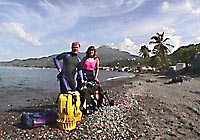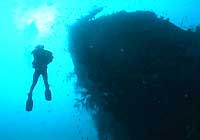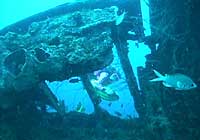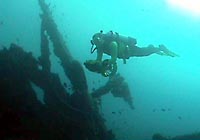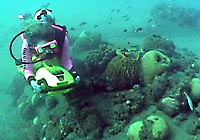 |
||||||||||||||||||||||
Today we make our first dive in Martinique looking for ships sunk by the eruption of Mont Pele on 1902. As we drive to St. Pierre, Mont Pele looks peaceful, just as people must have thought back at the start of the 20th century. On May 8, 1902, ships were anchored in the harbor waiting to load or unload passengers and cargo just as they had done for the last two centuries of St. Pierre's existence. They did not know it, but on that date those ships would be sunk by one of the most destructive volcanic eruptions people had ever seen! Today we dive with underwater explorer Lionel LaFont who has discovered 11 sunken ships in St. Pierre harbor due to the 1902 eruption. We will be exploring the largest of the wrecks, called Roraima (row-RAY-ma). Roraima was 120 meters long (longer than a football field), 25 meters wide and 40 meters high. It was a steel-hulled steam ship that carried passengers and cargo. When Mt. Pele erupted 50 people were onboard. Only 15 people survived. Roraima now rests upright at the bottom of the harbor. The bow is at about 150 feet underwater. The stern is at about 180 feet underwater. We will be using our underwater scooters for the first time during our expedition. The scooters will help us dive down to the wreck and explore it quickly. We will have only a short time to dive safely underwater to avoid getting decompression sickness (bends). After we check and put on our scuba diving equipment, we grab our scooters and zoom down to the bottom of the harbor. We zoom deeper and deeper until finally, the ship comes into view below us. At 154 feet underwater we stand on the sea floor and the bow towers over us. The ship looks kind of fuzzy. We see corals and sponges that are growing all over this wreck! The sinking of this ship was a tragedy, but now new life has sprung up on this wreck as it turns into a coral reef. The wooden deck and the structures above it were burned away, but the steel skeleton of this wreck remains, although it's slowly being destroyed by corrosion from the salty sea. We see holes in the ship's side, and entire sections of the ship have caved in. We don't go inside the wreck because if we accidentally bump into something, we could be trapped inside! Just as we reach the stern our dive computers show that we have stayed too long underwater to safely return directly to the surface. So we must now stop on our way to the surface and "decompress" before we can get up to the surface. After our decompression, we must wait for several hours before our next dive. Our next dive is on a smaller ship, the Raisinier (ray-ZEEN-yay), 40 meters long. Fortunately it is only about 30 feet deep so we have unlimited time to explore it. The ship is in several pieces scattered across the bottom. In this shallow water the wreck is continually beaten by big storm waves. It is now mostly a new reef and only a few large pieces rise up off the bottom. The Raisinier has become a home for various kinds of fish who peer out from their hiding places to watch us as we zoom back to surface to end our diving day. Dive with us again tomorrow when we will visit the coral reefs to see how they have adapted to survive after Mont Pele's eruption. |
Wayne and Karen on the beach in St. Pierre, Martinique, with their scuba equipment and underwater scooters. Notice Mont Pele in the background with its peak poking out from the clouds.
Karen cruises by the bow of the wreck, Roraima, on her underwater scooter. The "bushes" you see growing on the wreck are soft corals. Notice the fish swimming along the edge of the wreck.
Karen peeks into a hole in the side of Roraima as she cruises by on her underwater scooter. The wreck is covered with soft corals and large tube and vases sponges.
Wayne zooms up to the wreck, Raisinier, on his underwater scooter. Hard corals, soft corals, and sponges cover the pieces of the wreck that are scattered across the sea floor. Notice the fish around the wreck.
Karen cruises over a piece of the wreck, Raisinier. Notice how the side of the wreck has become a coral reef! |
|||||||||||||||||||||
home | basecamp | archives | other expeditions | kids' page | contact us © 2001, The Ocean Adventure All rights reserved. |
